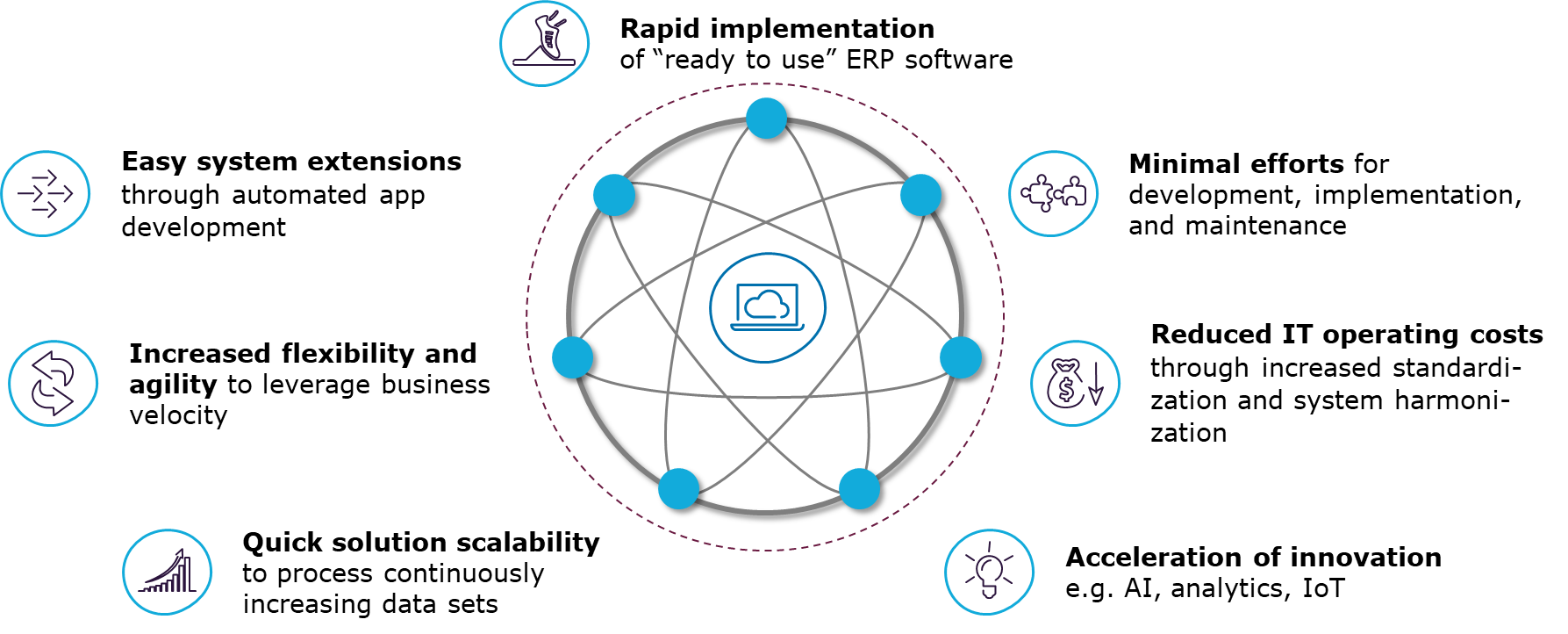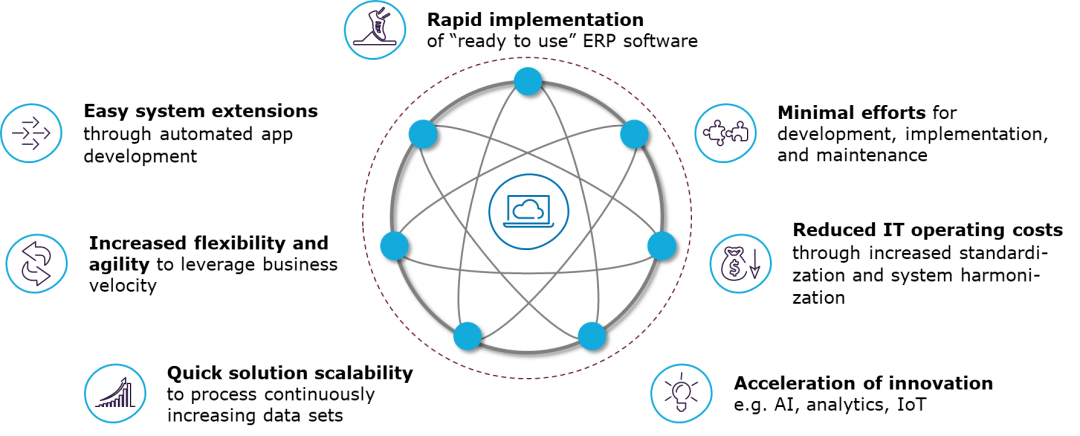Innovation accelerator cloud ERP
Blog: Capgemini CTO Blog
For many companies, historically grown ERP landscapes limit growth and innovation due to outdated technologies and lack of control options. Therefore, more and more companies are introducing cloud ERP SaaS solutions to invest in future-proof technologies. The top five reasons for implementing a cloud ERP solution for global companies in the discrete manufacturing industry can be found in our previous blog post: The next-generation ERP is cloud ERP.
These companies solve their massive innovation backlog with a cloud ERP implementation and use the cloud ERP implementation for a comprehensive business IT transformation.
After an accelerated implementation, the companies benefit from reduced operating costs, a scalable and flexible solution with continuous delivery of new functionality and technologies and easy extensibility through extensions (see Figure).

In my previous projects with global players from the discrete manufacturing industry, the following five reasons were the most frequently mentioned for the introduction of a new cloud ERP solution:
- Enabling comprehensive system-supported planning and control processes (e.g. introduction of integrated business planning and comprehensive data analysis)
- Optimization/standardization/automation of business processes (e.g. reduction of manual activities for order-to-cash and purchase-to-pay)
- Reduction of the high costs for operation and further development (e.g. for operation of the infrastructure and maintenance of the ERP applications)
- Mitigation of risks of legacy systems and implementation of future-proof technology (e.g. replacement of old SAP ERP or R/3 landscapes and other ERP applications)
- Enabling business and IT innovation (e.g. digitization of products and use of IoT)
The enhancement with extensions and the provision of new functionality and technologies requires only very low development, testing, and operation efforts due to the multi-tenant cloud architecture. Most cloud ERP vendors provide a Platform-as-a-Service (PaaS) solution for the development of extensions. This enables agile development of customer-specific extensions with the highest possible degree of automation, which meet the requirements of a modern cloud architecture, i.e. support microservices, have automated infrastructure, and provide an automated development pipeline with a ready-to-use toolchain. This allows developers to focus on the code and continuously develop new functionality, test it automatically and publish it for use.
Leading ERP vendors have been focusing their investments on their cloud ERP solutions for several years now, constantly providing their users with new functionality and technologies. Investments in traditional on-premises solutions are being reduced more and more. Further development is usually first or even only for the cloud ERP solutions.
Platform for innovation in business and IT
Cloud ERP provides a platform for further innovation in business and IT through the continuous provision of innovations and expandability and does not only solve an innovation backlog once.
In the following list, I would like to highlight five cloud ERP features that represent a particularly high degree of innovation and added value.
- Continuous provision of new innovations for the business
Cloud ERP manufacturers are continuously developing their solutions, most of which are optimized for specific industries, and automatically provide their users with new functionality, e.g. intelligent digital assistants to support users and for use as an intelligent chatbot for customers or new functions for supply chain optimization and integrated planning. These new functionalities enable a higher degree of digitization and efficiency, optimized use of data, and thus improved business results.
- Quick adaptation to international, legal and regulatory requirements
The manufacturers of cloud ERP solutions guarantee automatic adaptation to legal and regulatory requirements for many countries, thus reducing the risk of compliance violations and fines. In addition, most cloud ERP solutions also offer a flexible localization option for country-specific adaptations and ready-to-use integration of other software solutions (e.g. connection to customs or regulatory authorities and compliance with DSGVO).
- State-of-the-art cybersecurity
Due to the accessibility via the internet, cloud ERP manufacturers invest massively in cybersecurity and react as quickly as possible to new threats. As a result, the data centers of cloud ERP manufacturers are much more secure than those of their users and offer a higher level of protection. Application security is also ensured together with the users, which means that access to the SaaS solution is many times more secure than access to most applications at the user companies.
- Accelerated development of customer-specific innovations
By providing a development platform for the development of extensions, cloud ERP users have the opportunity to generate customer-specific innovations. The development platform meets the requirements for optimized development in the cloud. This enables companies to continuously develop customer-specific innovations in an agile manner and, if required, to provide new functions and changes on a weekly or daily basis. In contrast to conventional development methods, which achieve a maximum of a few releases per year, this allows changes and new functionalities to be provided up to 2,000 times faster.
- Use of the latest technologies
Simple connection of third-party applications and integration of IoT data sources as well as the use of artificial intelligence to automate processes and analyze data are no longer dreams of the future but can be used as standard functionality. The development of these technologies and of new innovations are the focus of cloud ERP solutions.
Artificial intelligence and machine learning
Cloud ERP manufacturers are developing more and more intelligent services based on machine learning to automate processes and enable forecasts, e.g. to reconcile invoices and predict sales volumes.
Integrated real-time data analysis
Cloud ERP solutions offer analysis functions for all users, which are not started separately, but integrated in the software functionality. This means that relevant information is directly integrated and available in real time during the execution of processes. The integrated functionality for data analysis enables fast data-based decisions. In addition to the transparency of all relevant aspects, intelligent, context-related forecasts are also made possible. For example, integrated analyses of production quantities and forecasts can be displayed during production planning, or additional manual correction requirements can be displayed, if an order item is corrected manually. The processing speed of data analyses in the cloud is also many times faster than in most companies’ own data centers.
Internet-of-Things (IoT) Integration
Cloud ERP offers simple integration of IoT devices and is therefore able to use IoT data and automate processes, e.g. a sensor message from a machine can automatically start a service process.
Digital manufacturing
Cloud ERP also enables the control of digital manufacturing, e.g. instead of producing spare parts in stock, a demand-driven automatic additive production of spare parts and automated direct delivery.
Augmented reality
The use of augmented reality not only helps users to become more efficient and reduce errors, but also allows them to carry out operations for which they have not been trained, e.g. machine retooling with the help of instructions and visualizations superimposed on holo-glasses or the use of smartphone cameras to superimpose contextual information.
Completely digitalized business processes
Due to difficult circumstances when entering data, e.g. in logistics, processes are not always completely digitalized. The use of mobile devices, handwriting recognition and speech recognition enables many more processes to be completely digitized, thus increasing efficiency and improving data usability.
Companies can use cloud ERP to accelerate innovation and digitization, thereby creating competitive advantages and the basis for further growth.
Capgemini Invent is a pioneer in cloud ERP
There are very few global companies with more than 1,000 ERP users and more than EUR 500 million turnover in the discrete manufacturing industry in Germany that have already started cloud ERP multi-tenant SaaS projects. We, at Future of Technology at Capgemini Invent, have been involved in all of them and are therefore a pioneer. Capgemini Invent is the only consultancy with practical cloud ERP experience in the discrete manufacturing industry (including automotive). Our innovative approach to strategy, selection, initialization, and implementation is a tremendous accelerator and can significantly reduce project times.
To learn more about Capgemini Invent’s Cloud strategy transformation solutions, click here.
Feel free to contact me at any time with your questions about ERP, Cloud, DevOps and AI. I look forward to the discussion.
Leave a Comment
You must be logged in to post a comment.








